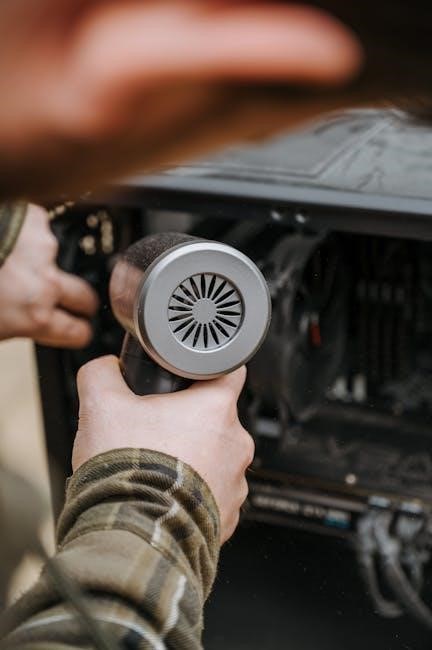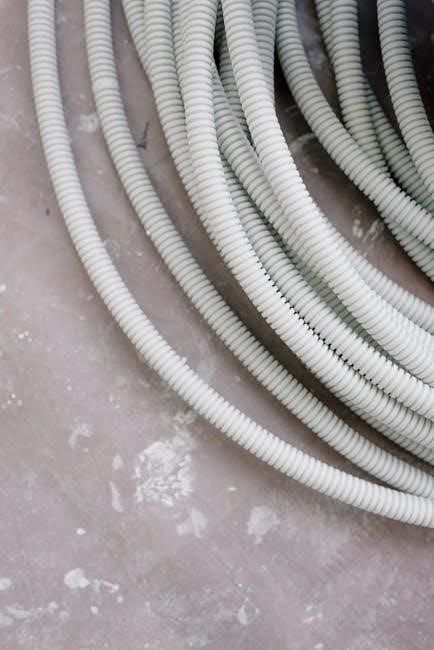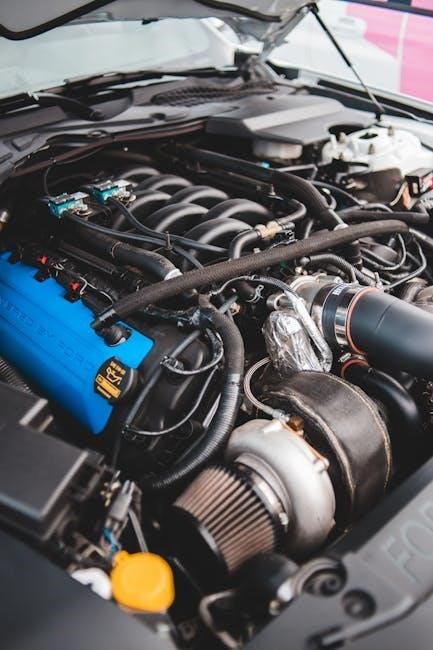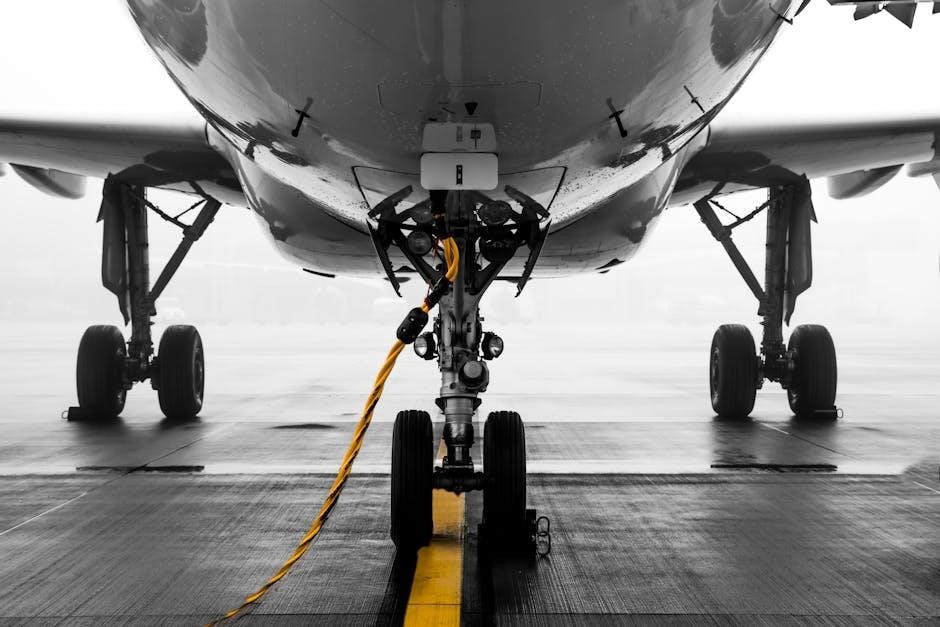The Porter-Cable 150 PSI Air Compressor manual provides essential guidance for safe and efficient operation, maintenance, and troubleshooting. It is available online via ServiceNet for easy access.
1.1 Importance of the Manual for Safe and Efficient Operation
The manual is crucial for understanding safety guidelines, features, and proper operation. It provides detailed instructions to prevent accidents and ensures efficient use of the compressor. By following the manual, users can maintain optimal performance, perform routine maintenance, and troubleshoot common issues. Regularly reviewing the manual helps extend the compressor’s lifespan and ensures safe operation. Always refer to it before starting the compressor for the best experience.
1.2 Overview of the Porter Cable 150 PSI Air Compressor Features
The Porter-Cable 150 PSI Air Compressor features a compact, rugged design with a 6-gallon steel tank, oil-free pump, and user-friendly controls. It delivers a maximum pressure of 150 PSI, making it versatile for various applications. The oil-free pump reduces maintenance, while the portable design enhances convenience. Its efficient operation and durable construction ensure reliable performance for both home and professional use, supported by a comprehensive manual for optimal functionality.

Key Features of the Porter Cable 150 PSI Air Compressor
The Porter-Cable 150 PSI Air Compressor features a 6-gallon steel tank, oil-free pump, and portable design. It delivers 150 PSI maximum pressure for versatile applications.
2.1 Maximum Pressure of 150 PSI for Versatile Applications
The Porter-Cable 150 PSI Air Compressor delivers a maximum pressure of 150 pounds per square inch, ensuring versatile performance for various applications. This high-pressure capacity supports tasks such as inflating tires, powering pneumatic tools, and operating nail guns efficiently. The compressor’s robust design and reliable operation make it suitable for both professional and DIY projects, providing consistent airflow and pressure needed for demanding tasks.
2.2 Compact and Rugged Design with a 6-Gallon Steel Tank
The Porter-Cable 150 PSI Air Compressor features a compact and rugged design, paired with a durable 6-gallon steel tank. This construction ensures long-lasting performance and portability, making it ideal for both home and professional use. The steel tank is built to withstand harsh environments, while its compact size allows for easy transport and storage. This design balances durability and convenience, providing reliable airflow for various applications.
2.3 Oil-Free Pump for Minimal Maintenance
The Porter-Cable 150 PSI Air Compressor is equipped with an oil-free pump, significantly reducing maintenance requirements. This design eliminates the need for oil changes, ensuring reliable operation with less downtime. The oil-free pump also contributes to a cleaner workspace and reduces long-term ownership costs. Its durability and low-maintenance design make it a practical choice for both casual and frequent users, providing consistent performance without the hassle of regular lubrication.
2.4 Portability and User-Friendly Controls
The Porter-Cable 150 PSI Air Compressor is designed for easy portability, featuring a compact and lightweight construction with a built-in handle. Its user-friendly controls include a simple pressure regulator and gauge, making it easy to adjust settings. The intuitive design ensures smooth operation, catering to both professionals and DIY enthusiasts. This combination of portability and straightforward controls enhances versatility, allowing users to tackle various tasks with ease, whether in a workshop or on the go.

Safety Guidelines and Precautions
Always follow safety guidelines to prevent accidents and ensure optimal performance. Wear protective eyewear, ensure proper ventilation, and avoid overloading. Operate within the 50% duty cycle to prevent overheating. Follow manual instructions carefully.
3.1 General Safety Tips for Operating the Compressor
Always wear safety goggles and ensure proper ventilation. Avoid overloading the compressor and operate within the 50% duty cycle to prevent overheating. Keep the compressor on a stable, level surface and ensure all connections are secure. Never exceed the maximum pressure of 150 PSI. Drain moisture daily to prevent corrosion and check hoses for damage. Follow all safety symbols and guidelines outlined in the manual for safe operation.
3.2 Understanding Safety Symbols and Warnings
Familiarize yourself with safety symbols in the manual. A warning triangle indicates potential hazards, while a caution symbol alerts to specific risks. A danger symbol signifies severe hazards that could cause injury. Understanding these symbols ensures safe operation and helps prevent accidents. Always review the manual’s safety section to interpret symbols correctly and follow instructions. Ignoring warnings can lead to serious safety risks and equipment damage.
3.3 Proper Ventilation and Workspace Setup
Ensure proper ventilation by placing the compressor in a well-ventilated area to avoid inhaling fumes. Keep the workspace clean and clear of clutter to prevent accidents. Place the compressor on a stable, level surface for balanced operation. Maintain a safe distance from flammable materials and ensure good airflow around the unit. Proper workspace setup enhances safety, efficiency, and prevents overheating, ensuring optimal performance of the Porter-Cable 150 PSI Air Compressor.

Components of the Porter Cable 150 PSI Air Compressor
The compressor features a motor, pump, pressure switch, and air tank, working together to compress, store, and regulate airflow efficiently for optimal performance and reliability.
4.1 Motor and Pump Assembly
The Porter-Cable 150 PSI Air Compressor features a powerful electric motor that drives the oil-free pump. The pump compresses air into the steel tank, ensuring efficient operation. Its oil-free design reduces maintenance needs and enhances reliability. The motor and pump assembly work seamlessly to deliver consistent airflow, with the pump operating quietly and efficiently. This durable construction ensures long-lasting performance and reliable service for various applications, making it ideal for both home and professional use; Regular inspection is recommended for optimal functionality.
4.2 Pressure Switch and Air Tank
The Porter-Cable 150 PSI Air Compressor includes a 6-gallon steel air tank and a pressure switch that regulates the compressors operation. The pressure switch automatically shuts off the motor when the tank reaches 150 PSI and restarts when the pressure drops. This ensures efficient cycling and prevents over-pressurization. The durable steel tank stores compressed air for consistent tool operation, while the pressure switch maintains safe and efficient performance, making it a reliable component for both home and professional use. Regular checks are essential for optimal functionality and safety.
4.3 Air Hose and Fittings
The Porter-Cable 150 PSI Air Compressor includes a durable air hose and fittings designed to withstand high-pressure demands. The hose is flexible and resistant to kinking, ensuring consistent airflow. Fittings are constructed for secure connections, minimizing leaks. Regular inspection of the hose and fittings is essential to maintain performance. Use only high-quality, 150 PSI-rated hoses and fittings to ensure safety and reliability. Proper maintenance extends the lifespan of these components, ensuring efficient operation of the compressor and connected tools.

Initial Setup and First-Time Use
Unpack and inspect the compressor for damage. Connect the air hose securely, ensuring all fittings are tight. Follow manual guidelines for proper setup and first-time use.
5.1 Unpacking and Inspecting the Compressor
Begin by carefully unpacking the Porter-Cable 150 PSI Air Compressor from its box. Inspect the unit for any visible damage or defects. Verify that all components, including the air tank, motor, and accessories, are included. Check for any loose connections or parts. Ensure the compressor is placed on a level, stable surface. Refer to the manual for a detailed list of included items and initial setup requirements. This step is crucial for ensuring safe and proper operation. The compressor is designed for a 50% duty cycle, meaning it should not run more than 50% of the time in any one-hour period. Proper unpacking and inspection help prevent future issues and ensure optimal performance.
5.2 Connecting the Air Hose and Tools
Connect the air hose to the compressor’s outlet port and the tool’s inlet port. Use a hose rated for at least 150 PSI to ensure safety and performance. Avoid kinking or twisting the hose, as this can restrict airflow. Secure all fittings tightly to prevent leaks. Use quick-connect fittings for easy tool changes. Always inspect the hose and connections for damage before use. Proper connections are essential for maintaining optimal airflow and pressure. Refer to the manual for specific fitting recommendations and compatibility. Ensure the system is leak-free for efficient operation.
5.3 Initial Startup and Pressure Testing
Before first use, inspect the compressor for damage and ensure all parts are securely tightened. Attach the air hose to the outlet port and test the system at a low pressure setting. Ensure the tank is empty and the drain valve is open. Turn on the compressor and allow it to build pressure gradually. Monitor the pressure gauge to ensure it reaches the maximum 150 PSI safely. Once pressurized, turn off the compressor and check for leaks in the system. This setup ensures optimal performance and safety for initial operation.

Operating the Compressor
Power on the compressor, allowing it to pressurize the tank to the set 150 PSI maximum. Use the regulator to adjust output pressure for tools and ensure smooth operation.
6.1 Powering On and Pressurizing the Tank
Before powering on, ensure the tank is empty and the drain valve is open. Plug in the compressor, turn the switch on, and allow it to pressurize. Monitor the pressure gauge to ensure it reaches the maximum 150 PSI safely. Avoid over-pressurization and always follow the manual’s guidelines. Regular maintenance and checks for leaks are essential for optimal performance and safety during operation.
6.2 Adjusting the Pressure Regulator
To adjust the pressure regulator, turn off the compressor and drain the tank. Locate the regulator knob near the gauge. Turn clockwise to increase pressure or counterclockwise to decrease it. Monitor the gauge to match your tool’s requirements. Avoid over-pressurization. Test the settings with your tools and refer to the manual for specific instructions. Regular maintenance ensures optimal performance and safety during operation.
6.3 Connecting and Using Air Tools
Connect air tools by attaching the hose to the compressor’s outlet and the tool’s inlet. Ensure compatibility and secure fittings. Start with low pressure, gradually increasing as needed. Monitor airflow and pressure to match tool requirements. Avoid exceeding the compressor’s SCFM ratings or duty cycle limits. Properly shut off tools and drain moisture after use to maintain efficiency and extend tool longevity. Always follow manual guidelines for safe operation.

Maintenance and Care
Regular maintenance ensures optimal performance. Drain the tank daily to remove moisture, clean the air filter, and inspect hoses for leaks. Store the compressor in a dry, cool place to prevent rust and damage. Follow the recommended duty cycle and SCFM ratings for efficient operation. Regular maintenance extends the life and efficiency of your Porter-Cable 150 PSI air compressor.
7.1 Daily Draining of the Air Tank
Drain the air tank daily to remove moisture, preventing rust and corrosion. Locate the drain valve at the bottom, turn it counterclockwise, and allow air and moisture to escape completely. Close securely after draining. Ensure the compressor is off and pressure gauge reads zero for safety. Regular draining extends the compressor’s lifespan and ensures optimal performance. This simple step is crucial for maintaining efficiency and reliability.
7.2 Regular Inspection of Hoses and Connections
Inspect hoses and connections regularly for damage, leaks, or wear. Ensure all fittings are tight and secure. Replace any damaged or corroded parts immediately. Use only Porter-Cable approved hoses rated for at least 150 PSI. Check for signs of cracking, fraying, or abrasions on the hoses. Proper maintenance ensures safe operation, prevents air leaks, and maintains optimal airflow. Regular checks extend equipment life and reliability, ensuring efficient performance.
7.3 Cleaning and Replacing the Air Filter
Clean or replace the air filter regularly to ensure optimal airflow and performance. Remove the filter and gently brush off dirt or debris. If damaged, replace it with a Porter-Cable approved filter. A clean filter prevents dust and contaminants from entering the compressor, reducing wear and tear. Regular maintenance ensures efficient operation, maintains compressor longevity, and prevents overheating. Always follow the manual’s guidelines for filter replacement to guarantee reliable performance.

Troubleshooting Common Issues
Identify and address common issues like low pressure, leaks, or motor overheating. Refer to the manual for detailed solutions to ensure optimal performance and safety.
8.1 Low Pressure or Slow Airflow
Low pressure or slow airflow can result from kinked hoses, clogged air filters, or excessive moisture. Ensure hoses are unobstructed, filters are clean, and the tank is drained daily. Check for leaks in connections and fittings, and tighten as needed. Regularly inspect and replace worn-out parts to maintain optimal performance. Refer to the manual for detailed troubleshooting steps.
8.2 Leaks in the System
Leaks in the Porter-Cable 150 PSI Air Compressor can occur due to loose connections or damaged hoses and fittings. Inspect all connections, tighten any loose fittings, and replace worn or damaged parts. Check the drain valve for proper function, as a malfunctioning valve can cause air leakage. Use soapy water to detect leaks; bubbles will form at the source. Regular maintenance ensures system integrity and optimal performance.
8.3 Motor Overheating or Shutdown
Motor overheating or shutdown in the Porter-Cable 150 PSI Air Compressor can occur due to excessive duty cycle use or poor ventilation. Ensure the compressor operates in a cool, dry environment and adheres to the 50% duty cycle. Check for blockages in the air filter or intake vents. If overheating occurs, turn off the compressor, allow it to cool, and inspect for issues before restarting. Proper maintenance prevents motor damage.

Frequently Asked Questions (FAQs)
This section addresses common inquiries about the Porter-Cable 150 PSI Air Compressor, including questions about duty cycles, troubleshooting, and maintenance. Refer to the manual for detailed guidance.
9.1 What is the Duty Cycle of the Compressor?
The Porter-Cable 150 PSI Air Compressor operates on a 50% duty cycle, meaning it can run for 30 minutes out of every 60-minute period. This ensures optimal performance without overheating, making it suitable for demanding tasks while maintaining reliability and efficiency. Always adhere to this cycle for safe operation and to extend the compressor’s lifespan.
9;2 Can the Compressor be Used for Continuous Operation?
The Porter-Cable 150 PSI Air Compressor is not designed for continuous operation. It operates on a 50% duty cycle, allowing 30 minutes of runtime followed by a 30-minute cooldown period. Exceeding this limit can cause overheating, reducing efficiency and lifespan. Always adhere to the duty cycle to ensure safe and reliable performance, avoiding potential damage to the motor or pump. Proper usage ensures optimal functionality and extended service life.
9.3 How to Reset the Pressure Switch
To reset the pressure switch, turn off the compressor and unplug it. Allow the unit to cool down completely. Drain the air tank by opening the drain valve. Once cooled, plug in the compressor and turn it on. The pressure switch will automatically reset. If issues persist, check for blockages or incorrect pressure settings. Always refer to the manual for detailed reset procedures and safety guidelines to ensure proper operation and prevent damage.

Warranty and Service Information
The Porter-Cable 150 PSI Air Compressor is backed by a comprehensive warranty. Contact customer support directly for service inquiries or visit authorized centers for professional assistance.
10.1 Warranty Coverage and Duration
The Porter-Cable 150 PSI Air Compressor is covered under a limited warranty, ensuring protection against defects in materials and workmanship. The warranty duration varies by product and region, typically ranging from one to five years. Specific terms, including coverage details and duration, are outlined in the manual or on the manufacturer’s website. Registration may be required for warranty activation. Always review the warranty document for precise conditions and exclusions.
10.2 Contacting Porter-Cable Customer Support
Porter-Cable provides dedicated customer support to assist with inquiries, troubleshooting, and warranty claims. You can contact them via phone, email, or through their official website. Visit their website for regional contact details and support options. Representatives are available to help with product-related questions, repair services, and warranty issues. Ensure to have your product model number ready for efficient assistance. Porter-Cable’s customer support team is committed to resolving issues promptly and effectively.
10.3 Finding Authorized Service Centers
To locate an authorized Porter-Cable service center, visit their official website and use the service center locator tool. Enter your location or zip code to find nearby centers. Ensure the center is authorized to maintain warranty validity and provide genuine parts. Contact Porter-Cable customer support for assistance if needed. Always verify the center’s authorization to ensure quality service and compliance with manufacturer standards.
